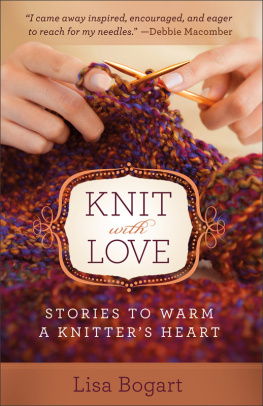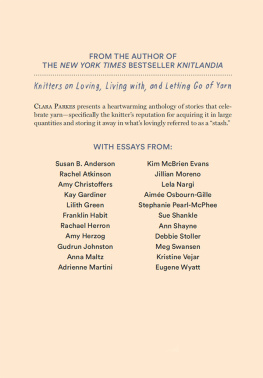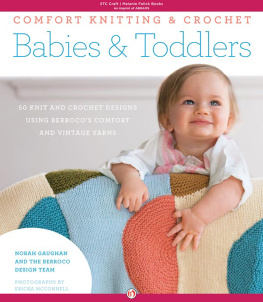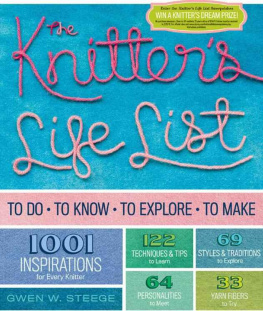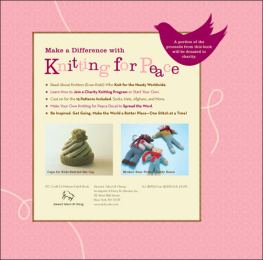KNITTING YARNS
and
SPINNING TALES
A KNITTERS STASH OF WIT AND WISDOM
EDITED BY KARI CORNELL

Permissions
Knitting Daughter from Two Sweaters for My Father by Perri Klass. Copyright 2004 by XRX Books. First published in the Spring 2004 issue of Knitters magazine. Used by permission of Perri Klass and XRX Books.
Animal Comfort from Knitting Heaven and Earth: Healing the Heart with Craft by Susan Gordon Lydon, copyright 2005 by Susan Gordon Lydon. Used by permission of Broadway Books, a division of Random House, Inc.
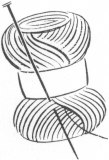
CONTENTS

Chapter 1:
ALL IN THE FAMILY
Chapter 2:
BABY NEEDS A NEW PAIR OF...
Chapter 3:
WORLDLY KNITS
Chapter 4:
TO BE A KNITTER
Chapter 5:
THE ZEN OF KNITTING
Chapter 6:
GETTING HOOKED ON CROCHET,
KNITTINGS SECOND-COUSIN

INTRODUCTION
Shortly after I was born, my mother taught herself to knit from a book, making herself a beautiful gray sweater with a complicated cable pattern. Unfortunately, the sweater was too small, and so, after it languished in the bottom of a dresser drawer for a year or more, she finally packed it in a paper grocery bag with a few other discarded items of clothing and toted it off to Goodwill.
I dont think I would have heard the story of the sweater had I myself not learned to knit, some thirty years later. When my mother first told me about it, I was shocked that she had given the sweater away. The very idea brought to mind a flood of questions. Did the sweater still exist? Where was the sweater now and who had worn it over the years? And, perhaps most importantly, could I have worn it at some point? How many more sweaters would there have been had mom continued to knit?
A year ago last Thanksgiving, I taught my mother to knit... again. The two of us toured local yarn shops one overcast Friday afternoon in search of the perfect project, needles, and yarn for her to begin. We found a simple but fun scarf pattern that called for a funky variegated yarn to be knit lengthwise on a circular needle. She selected a couple of skeins in shades of blue, green, and gray, and we headed home. She boiled water for wild raspberry tea before we sat down in the living room where I taught her how to cast on and then showed her the knit stitch.
The going was awkward at first, but by Sunday evening she had completed her first scarf, dropping only a few stitches along the way. I was impressed with her progress. Over the months that followed, she knit several scarves, each one better than the last. Shes since expanded her repertoire, knitting a sweater (It looks store-bought! my husband exclaimed) for herself and an adorable cap and sweater set for my son Will.
For each of us, knitting has become more than a craft to occupy our time during long car rides or while watching TV in the evenings. Knitting has become something my mom and I share. These days, when we talk on the phone each week, we ask each other about our knitting projects. We exchange ideas, give each other knitting books as gifts, and work through rough spots together.
In a way, our knitting relationship is a microcosm for the larger knitting community. No, I cant physically gather with knitters from around the country to knit and chat as I do with my mom or members of my knitting club. But I can collect the essays of knitters from all over North America into this book for knitters everywhere to read, relate to, and share with others.
The essays in this collection range from shearing sheep on a Sunday afternoon in March to an evening in SantArsenio, Italy, where women gather on their doorsteps to knit, crochet, embroider, and chat. Other essays delve into the psyche of the knitterWhat is it that makes us want to collect skein after skein of yarn that we may never use? Why do we find those romantic scenes depicted in pattern books so entrancing? Why is it that the appetite for new knitting projects always seems so much greater than what we can actually achieve in a lifetime?and, because crochet has become increasingly popular among knitters over the past few years, youll find a few essays by those whove become hooked on crochet. I hope you enjoy them all.
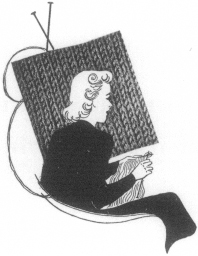
Chapter 1
ALL IN THE FAMILY
ONE OF MY EARLIEST MEMORIES HAS ALWAYS BEEN OF A DAY WHEN I PESTERED MY MOTHER TO TEACH ME HOW TO KNIT.
Elizabeth Zimmermann, Knitting Around, 1989
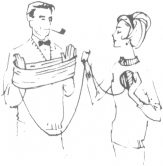
The survival of a craft such as knitting often rests on the shoulders of elders, who graciously pass the skill down to the next generation. The teacher usually is someone in the familya grandparent, parent, aunt, or uncle. Although the story of learning to knit is a universal one, the essays in this chapter reveal that the beginning knitter walks away with more than just knitting know-how. Many times they also gain a greater understanding and appreciation for the person teaching the lesson.
KNITTING DAUGHTER
BY PERRI KLASS
Memory works in mysterious ways. Years ago, writer Perri Klass taught her daughter to knit, hoping to pass on a favorite pastime. In her essay Knitting Daughter, which first appeared in the Spring 2004 issue of Knitters magazine, Perri interviews her daughter about the experience and discovers that her daughter remembers many details about the lesson that Perri herself had long forgotten.
Perri Klass is a pediatrician in Boston, and medical director of the national center for Reach Out and Read. She is the author of several books, including The Mystery of Breathing and Love and Modern Medicine. Klass is a regular columnist for Knitters magazine. A collection of her columns, Two Sweaters for My Father, was published by XRX in 2004.
My daughter Josephine is in tenth grade, and she hasnt touched her knitting in years and years. And of course I have my comedy routines about life with a teenage daughter (the eye-rolling... the moods... the making me feel Im the stupidest person in the universe...), and presumably she has her comedy routines about life with mother. And I wanted to write about teaching her to knit, but I wanted to write about it honestlywithout too much saccharine nostalgia for the child she was, not so long ago, without too much false and self-congratulatory enhancement of my own skills as a mother, and above all, without pretending that the lesson really took. You mothers of adolescent daughters, I think, will understand that treacherously easy nostalgia for the lost cozy days of uncomplicated hugs, and most will probably also understand the mild trepidation with which I proposed to her, finally, a formal interview.


